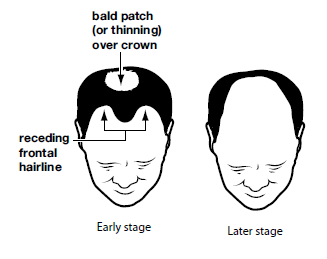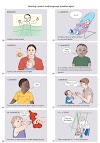Male Baldness
Baldness is a painless and slow process of hair loss and most of the
cases it comes with the increasing of age. In medical term, it is called alopecia. Androgen or male hormones have an effect on such alopecia/baldness. It is also a natural process and
most runs in a family. Considering all these, it can be named as androgenetic alopecia.
At normal condition, about 100 hairs on the scalp are shed every day. Approx 60% of men, by the age of
50, usually have significant hair loss.
What is the normal pattern of male baldness?
Initially, the front hairline starts to recede in the temple and
frontal area. At the same time the hair over the crown (top) start becoming
thin (look at the picture).
In some men, this condition may persist rest of his life while in
others, the top and frontal area eventually meet, and ultimately affect the
whole head (scalp). Those who start losing hair in an earlier age are
affected more in the long run.
What are the causes of male baldness?
Male hormone (Testosterone) plays an important role here. It is
believed that if a man is castrated at a young age, he won't go bald.
In some rare instance, sudden severe illness might cause hair loss but
when the illness is over, the hairs return back (usually within 3 months).
Some chronic illness (long-standing) also might be a causative factor,
notably thyroid disorders and iron deficiency anaemia. Also, some fungal
infections of the scalp can cause bald patches (total head baldness is unusual
in fungal infection).
Some drugs/medicines, e.g. cytotoxic drugs, mostly used in cancer patients, can cause hair loss. When the drug is stopped, hair usually regrows.
There is a specific hair loss disorder known as alopecia which may
present as round bald patches (alopecia areata) or may involve the whole head
(alopecia totalis)
What measures should be taken?
Although it is embarrassing and upsetting initially, most men accept
this natural baldness eventually. Moreover, it is an incurable condition
(mostly). A doctor also doesn't have much to do except persuading them accepting
the baldness.
Those who can't accept it, they may try these approaches: A toupee, or a wig, or
cutting hair very short and keep it that way, or go for hair transplant (the
implanted hair might have the same fate of that original hair)
Regarding medications: Medicated shampoos and ointments don't do much
help, and should be avoided. The tempting commercial advertisement also doesn't
do any differences. Two drugs are currently available which might help. One is
Minoxidil lotion/gel (to apply directly to the scalp) and another one is
Finasteride (Tablet). But we should keep in mind that these are expensive, not
equally effective for everybody and (if have a good result) need to continue
rest of life.
[Source of image and information: John Murtagh's Patient Education]





0 Comments